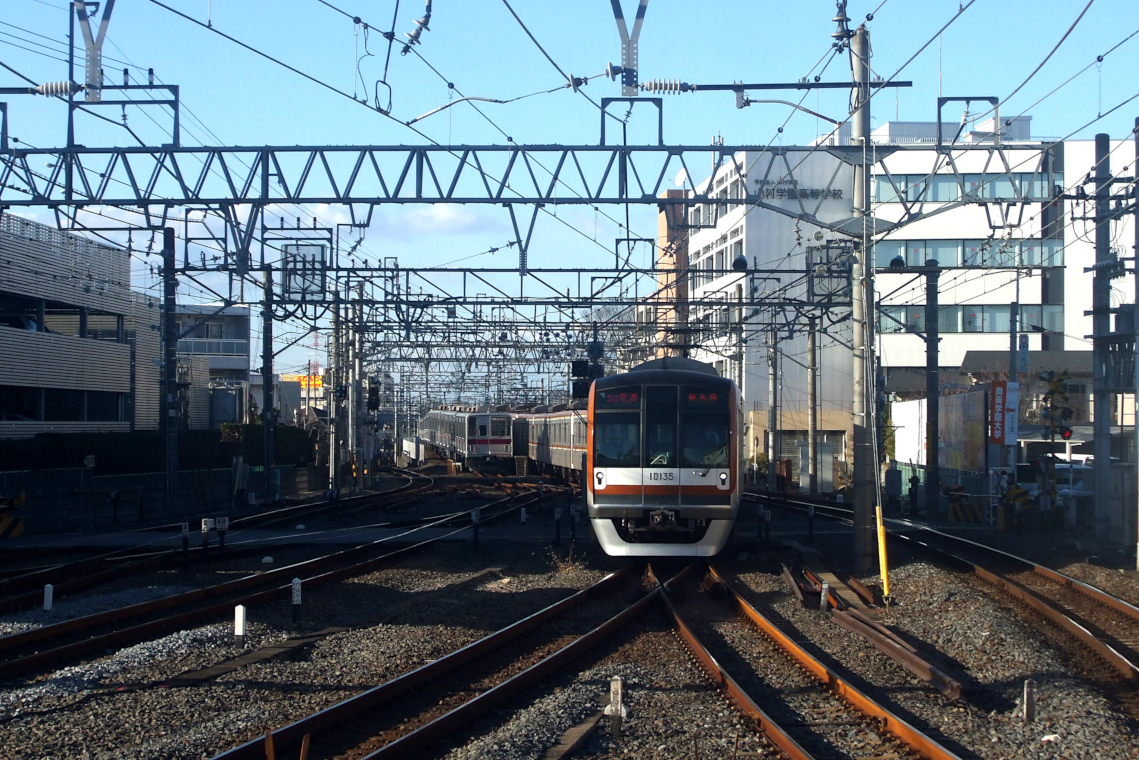Du bist nicht eingeloggt | Einloggen | anmelden
Nicht sichtbar

965479
:
1
1
Hitachi Tokyo Metro 10000 series #10135
Baujahr: 2009Hochgeladen: 2019-03-03 11:49:49.55079
Aufnahmeort: 川越市 [Kawagoe-shi] / Saitama-ken
Breite: 1139, Höhe: 760
Dateigröße: 540.01kB
Dateigröße: 540.01kB
2 Januar 2019 - Kawagoe (Saitama Prefecture), northern end of Tōbu Railway`s Kawagoeshi station (埼玉県川越市-川越市駅).
Yūrakuchō/Fukutoshin/Tōyoko Line diagram 35S: C2135S/A1435S, Kawagoeshi 14:40 → Shin-kiba 16:03
One characteristic feature of many suburban and regional railways around Tokyo, but not limited to just the capital area, is the operational co-operation, that`s to say, through train running. This means that trains enter rail lines owned by completely distinct companies. In a lot of cases this is limited to just two lines and two companies, but here is an example from one of the biggest networks - seven distinct lines (Tokyo Metro Yūrakuchō and Fukutoshin lines, Tōkyū Tōyoko line, Seibu Ikebukuro and Yūrakuchō lines, and finally, as seen above, Tōbu Tōjō line) are operated with stock from five different companies (however, due to the geographical layout and safety system details, not all stock operates over all lines). Thus the double train number - C2135S only as far as Wakōshi, and A1435S from thereafter, once it enters the metro network.
Through train running as seen in Japan is quite convenient and helpful - for example, between the rush hours I have a direct train to Yokohama every 30 minutes. Mind you, Yokohama is 40 km away as the crow flies, but I would have to change trains twice otherwise. Unfortunately, this also means that an accident at one end of the puzzle affects passengers three companies, two hours` worth of travel and 80 kilometres away. That is critical when one considers the typical scheduling and planning methods in Japan, which rely heavily on trains with different stopping patterns, connections and taking each other over. In the most extreme of cases, one can even see stock which should not appear whatsoever on a particular diagram - that`s to say, stock from a different company.
Yūrakuchō/Fukutoshin/Tōyoko Line diagram 35S: C2135S/A1435S, Kawagoeshi 14:40 → Shin-kiba 16:03
One characteristic feature of many suburban and regional railways around Tokyo, but not limited to just the capital area, is the operational co-operation, that`s to say, through train running. This means that trains enter rail lines owned by completely distinct companies. In a lot of cases this is limited to just two lines and two companies, but here is an example from one of the biggest networks - seven distinct lines (Tokyo Metro Yūrakuchō and Fukutoshin lines, Tōkyū Tōyoko line, Seibu Ikebukuro and Yūrakuchō lines, and finally, as seen above, Tōbu Tōjō line) are operated with stock from five different companies (however, due to the geographical layout and safety system details, not all stock operates over all lines). Thus the double train number - C2135S only as far as Wakōshi, and A1435S from thereafter, once it enters the metro network.
Through train running as seen in Japan is quite convenient and helpful - for example, between the rush hours I have a direct train to Yokohama every 30 minutes. Mind you, Yokohama is 40 km away as the crow flies, but I would have to change trains twice otherwise. Unfortunately, this also means that an accident at one end of the puzzle affects passengers three companies, two hours` worth of travel and 80 kilometres away. That is critical when one considers the typical scheduling and planning methods in Japan, which rely heavily on trains with different stopping patterns, connections and taking each other over. In the most extreme of cases, one can even see stock which should not appear whatsoever on a particular diagram - that`s to say, stock from a different company.
Nicht sichtbar
Kommentare
- +1
O proszę. Sam musiałem analizować, na jakiej zasadzie to działa, potem dyskutowałem z Tobą pod innym zdjęciem, a teraz widzę, że tu wszystko opisałeś...
Deinen Kommentar abschicken
Benutzerfunktionen
Ähnliche Inhalte
Karte laden
Verlink uns
Link für Foren: [URL=https://phototrans.de/14,965479,0,Hitachi_Tokyo_Metro_10000_series_10135.html][img]https://phototrans.de/images/photos/original/244/965479.jpg[/img][/URL]
HTML: <a href="https://phototrans.de/14,965479,0,Hitachi_Tokyo_Metro_10000_series_10135.html"><img border=1 src="https://phototrans.de/images/photos/original/244/965479.jpg" alt="Taken from transport.wroc.biz"></a>






